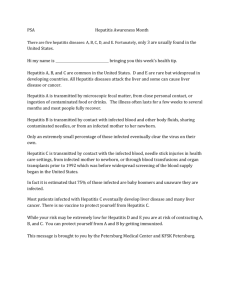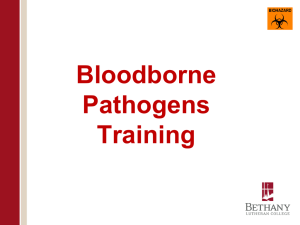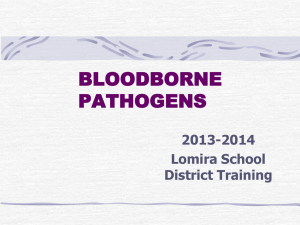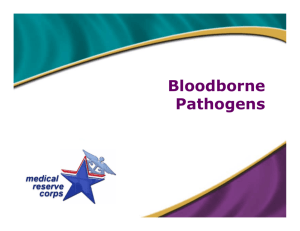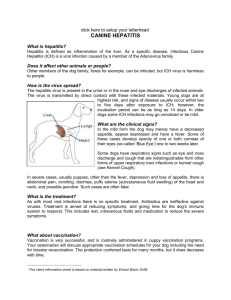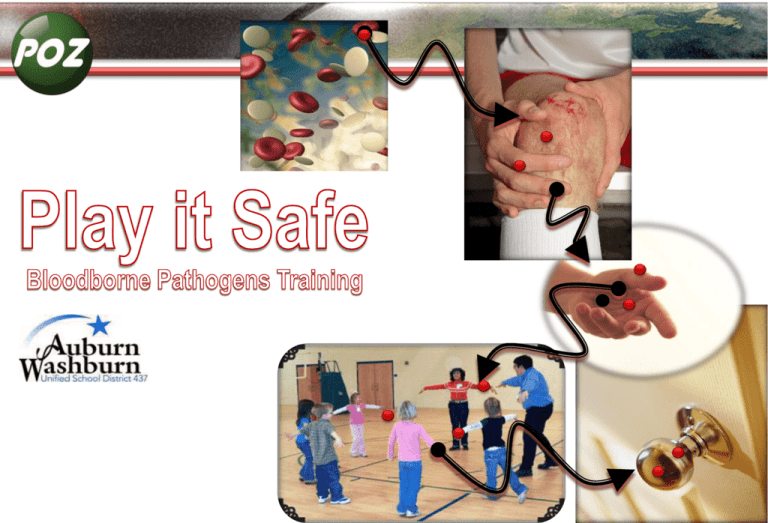
• The accompanying slides are
intended for the sole
use of PUR-O-ZONE
representatives and customers
for educational purposes. The
entire contents are copyrighted,
and use by other organizations
or entities is prohibited without
written consent.
EDUCATIONAL
MATERIAL
USE POLICY
The information contained in this
presentation is deemed accurate.
However, circumstances vary, and
recommendations presented
should be reviewed on-site by
qualified personnel before use.
Please call your PUR-O-ZONE
representative for free
consultation.
Entire contents copyrighted © 2013, PUR-O-ZONE, Inc. All rights reserved.
Custodial
Personnel
Need to
Understand
Personal
Protective
Equipment and
How Bloodborne
Pathogens are
Transmitted
What’s an OSHA & Why Does It Care ?
Occupational Safety and Health Administration
The Occupational Health and Safety Act - 1970
The Final Rule – 1991
Approximately 5.6 million workers in health care and
other facilities are at risk of exposure to bloodborne
pathogens
• Purpose : “Limits occupational exposure to blood and
other potentially infectious materials (OPIM) since any
exposure could result in transmission of bloodborne
pathogens which could lead to disease or death.”
- OSHA 29CFR1910.1030
•
•
•
•
• All employees who could be “reasonably anticipated” as
the result of performing their job duties to face contact
with blood and other potentially infectious materials.
• “Good Samaritan” acts such as assisting a co-worker
with a nosebleed would not be considered
occupational exposure.
• Physicians,
personnel
and emergency room
• Dentists and other dental workers
• Laboratory and blood bank technologists
and technicians
• Medical examiners
•
•
•
•
Morticians
Law enforcement personnel
Firefighters
Paramedics and EMTs
• Medical waste treatment employees
• Home healthcare workers
• Administering first aid – needlesticks.
• Using a tool covered with dried blood?
• Cleaning the restrooms?
– Feminine hygiene disposal
– Cleaning toilet fixtures
“Bloodborne Pathogens (BBPs)
means pathogenic microorganisms that are
present in human blood and can cause disease
in humans.”
DEFINITION
• Definitions:
– Bloodborne –
carried in the blood
– Pathogens - disease causing
microorganisms
• CFR 1910.1030 specifically addresses:
– HIV - Human Immunodeficiency Virus
– HBV - Hepatitis B Virus
– HCV – Hepatitis C
• Our presentation also covers other
concerns you should understand.
HIV is a bloodborne virus that attacks the immune
system rendering the body unable to fight
disease.
• At the end of 2009 (most current available), an
estimated 1,039,000 to 1,185,000 persons in the
United States were living with HIV/AIDS, with 2427% undiagnosed and unaware of their HIV
infection.
– Number of new AIDS cases: 44,232 (2009)
• Go to : www.statehealthfacts.org for the latest
statistics in any state
• Hepatitis B is a serious disease caused by a virus that
attacks the liver.
– The virus, which is called hepatitis B virus (HBV), can cause
lifelong infection, cirrhosis (scarring) of the liver, liver cancer,
liver failure, and death.
• The virus is found in body fluids, including; saliva,
blood,urine; vaginal secretions; skin, tissue and cell
cultures and other bodily waste and fluids.
• Contact with infected blood & bodily fluids containing blood (saliva
with blood, urine with blood) which penetrate the skin through
scratches, cuts, bites or rashes may result in infection.
• HBV can also be spread by contaminated needles and syringes
or exposure to any other objects which may contain small traces
of human blood.
• Number of new infections per year has declined from
an average of 260,000 in the 1980s to about 73,000 in
2009.
• Highest rate of disease occurs in 20-49-year-olds.
• Greatest decline has happened among children and
adolescents due to routine hepatitis B vaccination.
• There are an estimated 1.25 million Americans
chronically infected
– 20-30% acquired their infection in childhood.
– 6 – 10% show no symptoms
• U.S.A. = 200,000 people/year infected
• 5,000 people = Die in U.S. /year
• 1 out of 20 U.S. people will get HBV in their lifetime.
• HIV is spread by sexual contact with an infected person,
by sharing needles with someone who is infected, or, less
commonly (and now very rarely in countries where blood
is screened for HIV antibodies), through transfusions of
infected blood or blood clotting factors.
• Babies born to HIV-infected women may become infected
before or during birth or through breast-feeding after
birth.
• In the health care setting, workers have been
infected with HIV after being stuck with needles
containing HIV-infected blood or, less frequently,
after infected blood gets into a worker’s open cut or
a mucous membrane (for example, the eyes or
inside of the nose).
• 1. Weakness, headache, fever, diarrhea, sore throat,
nausea, other “flu-like” symptoms.
• 2. Many infected people do not show symptoms for years
after unprotected exposure.
Golly!
Hepatitis B
can survive
in dried blood
for a week or
longer.
• Hepatitis B is transmitted through blood and infected bodily
fluids. This can occur through:
–
–
–
–
–
direct blood-to-blood contact
unprotected sex
unsterile needles
from an infected woman to her newborn during the delivery process.
Other possible routes of infection include sharing sharp instruments
such as razors, toothbrushes or earrings. Body piercing, tattooing
and acupuncture are also possible routes of infection unless sterile
needles are used
• Hepatitis B is NOT transmitted casually. It cannot be spread
through sneezing, coughing, hugging or eating food prepared
by someone who is infected with hepatitis B.
• Most people do not have noticeable symptoms when
they are first infected.
– Hepatitis B causes no symptoms in about 69 percent of
infected people.
– Approximately 30 percent of infected individuals think they
just have the flu and ignore the symptoms
• Common symptoms of hepatitis B infection include:
– Fever, fatigue, muscle or joint pain
– Loss of appetite
– Mild nausea and vomiting
• Serious symptoms that require immediate medical attention and
maybe even hospitalization:
– Severe nausea and vomiting
– Yellow eyes and skin ("jaundice")
– Bloated or swollen stomach
• Up to10% of HBV infected people are “symptomless”
chronic carriers.
Hepatitis C is also
a virus that causes
a disease of the liver.
• HCV is the most common chronic
bloodborne infection in the United States
• 80% of infected persons have no signs or symptoms.
• Number of new infections per year has declined from an average of
240,000 in the 1980s to about 30,000 in 2009.
• Estimated 3.9 million (1.8%) Americans have been infected with
HCV, of whom 2.7 million are chronically infected.
• Chronic infection: 55%-85% of infected persons
• Chronic liver disease: 70% of chronically infected persons
– Causes 8 – 10 Thousand deaths each year in the U.S.
• May triple within ten years, as people infected years ago are only
now starting to show signs of serious liver damage and liver failure.
• “The employer shall make available the hepatitis B
vaccine and vaccination series to all employees who
have occupational exposure, and post-exposure
evaluation and follow-up to all employees who have
had an exposure incident.”
• The vaccination series may be started AFTER an
exposure incident – the sooner the better
• You may decline the vaccination series, but you must
sign a declination form.
• You may change your mind.
• Must make available, free of
charge at a reasonable time
and place, to all employees
with occupational exposure
within 10 working days of initial
assignment unless:
– employee has had the
vaccination
– antibody testing reveals
immunity
• The vaccination must be
performed by a licensed
healthcare professional.
• IV drug use; blood or blood product transfusions; kidney
dialysis; accidental needlesticks (healthcare workers;
unprotected sexual activity; sharing items that may have
infected blood on them such as razors, toothbrushes,
etc.; ear and body piercing with contaminated
instruments; from mother to child at birth
• Symptoms include: jaundice, fatigue, abdominal pain,
loss of appetite,
intermittent nausea, vomiting
• May lead to chronic liver disease and death
MRSA is not a virus, but is an increasing threat to
health that often involves blood or body fluids.
It is “Methicillin-Resistant Staphylococcus
Aureus,” a bacteria.
C. diff is an especially
important concern
in assisted living,
healthcare, hospital
and general restroom
settings.
• “… means reasonably anticipated skin, eye,
mucous membrane, or parenteral contact with
blood or (OPIM) that may result from the
performance of an employee’s duties.”
• “Parenteral means piercing mucous membranes or
the skin barrier through such events such as
needle sticks, human bites, cuts, and abrasions.”
•
29 CFR 1910.1030 says:
–“Each employer having an employee(s) with
occupational exposure… shall establish a written
Exposure Control Plan designed to eliminate or
minimize employee exposure.”
• Identifies job and tasks that occupational exposure to
blood or other infectious materials may occurs
• Describes how employer will:
– Use engineering & work practice controls & Ensure use of
appropriate PPE
– Provide training & medical surveillance
– Provide hepatitis B vaccinations
– Use signs & Labels
• Exposure records
• Training records
• Name of
responsible person
• # 1. Universal Precautions
– Assume contamination
– Treat all blood and body fluids as if they are known to be
infected
– “Universal Paranoia”
• Treat every surface as if it is known to be contaminated
– The Hepatitis B virus has been shown to live on a dry surface for
10 days to two weeks
• # 2. Engineering and Work Practice Controls
– Sharps disposal containers; Self-sheathing needles; Safer
medical devices ( Needless systems & Sharps with engineered
sharps injury protection.
– Changing the way tasks are done to eliminate or minimize
occupational exposure
– Handwashing...
• # 3. Good Housekeeping Practices
– “All equipment and working surfaces shall be cleaned and
decontaminated after contact with blood or OPIM.”
– Containers that are to be reused which have a reasonable
likelihood for coming into contact with blood or OPIM… shall
be decontaminated on a regularly scheduled basis.
• Industrial accident
• Giving First Aid
• Post-accident
cleanup
• Maintenance and
Janitorial work
BLOODBORNE PATHOGENS AWARENESS
“Treat any body fluid
as if it were labeled
DANGER! ”
To better protect ourselves and to reduce
disease transmission,
we need to
understand
“fomites”
The Mosquito that Kept the French
from Completing the Panama Canal
Organism Examples (Vector):
Tick, mosquito, flea
Object Examples (Fomite):
Sheets, uniforms, towels
Object Examples (Fomite)
Object Examples (Fomite)
Keyboards, handles, buttons
Sheets, uniforms, towels
BULLY!
How Did Teddy Control
Vectors in Panama?
“I drained the swamps!”
Fomite
A fomite is an object
that facilitates the transfer of disease
from one human host to a new one.
Host
Fomite
Host
Cross-Contamination
Cross-contamination is the process
of infectious microorganisms
being moved from a host to a fomite
and picked up again by a new host.
Anywhere
People
Have Been
•
•
•
•
•
•
•
•
•
Restroom fixtures
Gym Equipment
Door Handles
Bedding
Counters
Lockers
Elevator Panels
Desktops
Railings
Viruses are so small they
can even enter through
chapped skin, eyes, mouth
or other mucous
membranes.
They travel in other cells,
even inside bacteria.
Large Bacteria
4 microns
LOOK
Virus
.025 microns
(needs cell to live)
AEROSOL
PARTICLE A
VIRUS MIGHT
TRAVEL ON
Large Mold
12 microns
INFECTED
INDIVIDUAL
PORTAL OF
ENTRY (MUCOUS
MEMBRANE)
HANDS OR SKIN
HANDS,
BODY FLUIDS
OR OPEN
WOUND
FOMITE
(INANIMATE
SURFACE)
You can have
the greatest impact
on disease transmission
in a building
by applying this principle:
Interrupt the
Cross – Contamination Cycle!
Interrupt the
Cross-Contamination Cycle
FEMININE HYGIENE RECEPTACLES
RESTROOM SURFACES
WATER FOUNTAINS
DESKS AND COUNTERS
WRESTLING MATS
LOCKER FACILITIES
EXERCISE EQUIPMENT
BODY FLUIDS IN LAUNDRY
DOOR AND LOCKER HANDLES
SHOWERS
CAFETERIA COUNTERS AND TABLES
PHONES AND KEYBOARDS
1.
2.
3.
4.
5.
6.
7.
8.
9.
Block off the area
Put on appropriate personal protective equipment
Apply absorbent material
Pick up absorbent and dispose into a red bag if your facility
has a red-bag program, if not use a double trash bag
Decontaminate the area
Decontaminate non-disposable tools
Dispose of single-use PPE – decontaminate re-usable PPE
Wash hands
Dispose of waste properly
Goggles, Aprons, Gloves
and Masks are all Appropriate PPE
Solution
Uses
GLOVES – EXAM GRADE
MASKS
APRONS
GOGGLES
CPR MASKS
- PROVIDE A BARRIER BETWEEN USER
AND INFECTION
- PROVIDE A RESPIRATORY CPR
BARRIER SO INFECTION DOES NOT
PASS EASILY IN EITHER DIRECTION
- GLOVES MUST BE HYPOALLERGENIC
- ACCESS MUST BE EASY/QUICK
Gloves are front-line defense
for any potential contact
with Bloodborne Pathogens.
Remove gloves
when they become:
1. CONTAMINATED,
2. DAMAGED,
3. OR BEFORE LEAVING
THE CLEAN-UP AREA.
PEEL ONE GLOVE OFF FROM TOP TO BOTTOM
HOLD IT IN THE GLOVED HAND.
PEEL THE SECOND GLOVE FROM THE INSIDE.
TUCK THE FIRST GLOVE INSIDE THE SECOND.
RED BAG THE BUNDLE PROMPTLY.
WASH HANDS THOROUGHLY.
AVOID SHARP ITEMS
BY PICKING THEM UP
WITH A DUST PAN OR
GRABBER ARM.
• Spray the area with
Disinfectant Cleaner
and let it “dwell” for
the prescribed time
on the label.
• Make sure the
product protects
against the
pathogens discussed
in this presentation.
• Use the powder in the
Bodily Fluid Spill
Control kit to make a
mound of powder
around the blood then
work toward the
center to absorb the
fluid.
• After the powder
absorbs the liquid it
can be scooped up
and placed in the
disposable bag.
• Spray the area again
with Disinfectant
Cleaner to perform a
final cleaning and
disinfection of the
surface.
• Maintain dwell time.
• Dispose of the scraper and
scoop with used absorbent
into the red plastic bag from
the kit – if your facility has a
red-bag program.
• Used towels and PPE can be
disposed of in the provided
plastic bag.
• Wash hands with towelettes
and put used towelettes into
bag.
• AFTER DISINFECTING
ALL SURFACES
INVOLVED AND
SURROUNDING THE
SPILL:
• RED BAG ALL
MATERIALS USED IN
THE CLEANUP.*
• Liquid or semi-liquid blood or OPIM
(other potentially infectious materials)
• Contaminated items that would release blood or OPIM
when compressed
• Items caked with dried blood or OPIM
that are capable of releasing such
• Contaminated sharps
• Pathological and microbiological
waste containing blood or OPIM
• Fluorescent Orange or Orange-Red
• All waste must be labeled or be in RED bags (if your
facility has a red-bag program)
• Hand washing is the
single most important
hygienic practice that can
reduce the chance that a
susceptible person will be
dangerously exposed to
infectious agents in blood
or other body fluids.
• “When a provision of handwashing facilities is not
feasible
– The employer shall provide either an appropriate antiseptic
hand cleanser
• with clean cloth/paper towels
– Or antiseptic towelettes.
• When antiseptic hand cleansers or towlettes are used,
hands shall be washed with soap and running water as
soon as feasible.”
• “Eating, drinking, smoking, applying cosmetics or lip
balm, and handling contact lenses are prohibited in work
areas where there is a reasonable likelihood of
occupational exposure.”
• The employer pays for cleaning, laundering, disposal,
repair, and replacement as needed.
• If PPE is penetrated it shall be removed immediately or
as soon as feasible.
• All PPE shall be removed prior to leaving the work area.
• When removed, it shall be placed in an appropriately
designated area or container.
• Contaminated laundry = handle with minimum agitation.
• “Contaminated laundry = bag or containerize at the use
location & not sorted or rinsed in the location of use.”
• Must be placed & transported in labeled or color-coded
containers.
• If facility uses Universal Precautions = soiled laundry,
alternative labeling or color coding is sufficient if it all
employees recognize the containers as requiring
compliance with Universal Precautions.”
• Wet laundry = In leak proof bags or containers.
• The employer = Provide PPE for those who handle
contaminated laundry.
• If contaminated laundry sent off-site to a second facility
which does not utilize Universal Precautions in the
handling of all laundry… must be labeled or color
coded…”
• “Following a report of an exposure incident, the employer
shall make immediately available to the exposed
employee a confidential medical evaluation and followup, including at least the following elements:
– Documentation of the route(s) of exposure
– The circumstances under which the exposure incident
occurred;…”
• “…Identification and documentation of the source
individual, unless the employer can establish that
identification is infeasible or prohibited by state or local
law;
• The source individual’s blood shall be tested as soon as
feasible and after consent is obtained in order to
determine HBV and HIV infectivity…”
When
Accidents
Happen
1
RESPOND
2
BLOCK
3
CLEAN
4
CALL*
• RESPOND TO INJURY OR INCIDENT
AFTER PUTTING ON APPROPRIATE PPE.
1
RESPOND
2
BLOCK
3
CLEAN
4
CALL*
• BLOCK OFF THE AREA
(TO PROTECT OTHERS)
AS SOON AS POSSIBLE.
• CLEAN THE PHYSICAL AREA
AS SOON AS POSSIBLE
AFTER SPILL.
• OR CLEAN YOURSELF FIRST
IF ACCIDENTALLY EXPOSED
TO FLUIDS.
• CALL TO REPORT ANY EXPOSURES
TO APPROPRIATE SUPERVISOR.
BLOODBORNE PATHOGENS AWARENESS
“Treat any body fluid
as if it were labeled
DANGER! ”
Thank you for Your Attention



